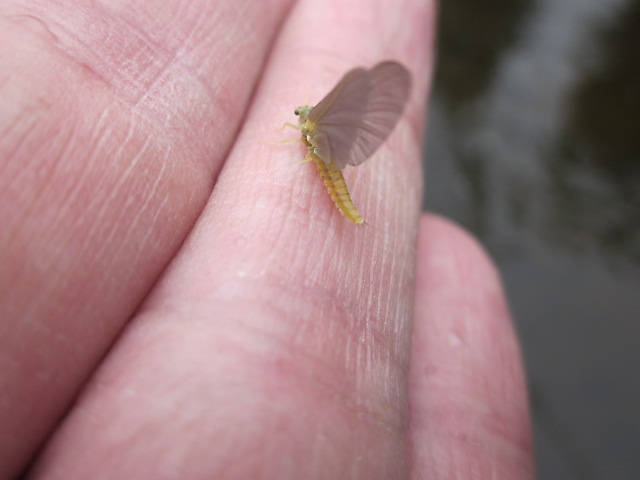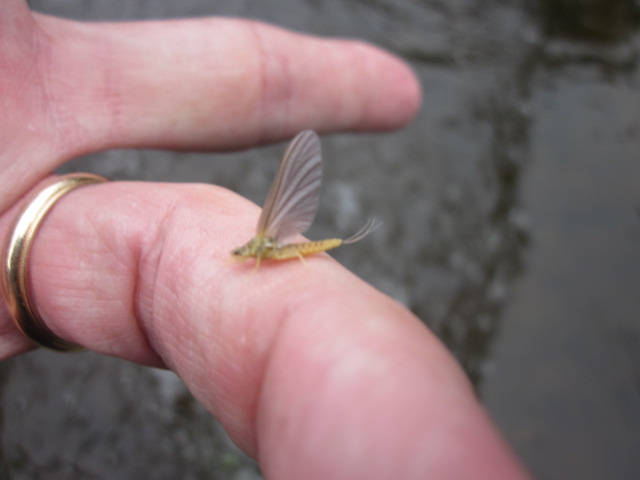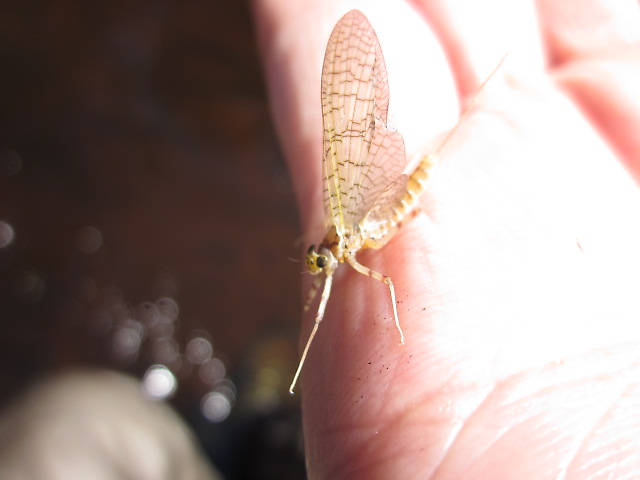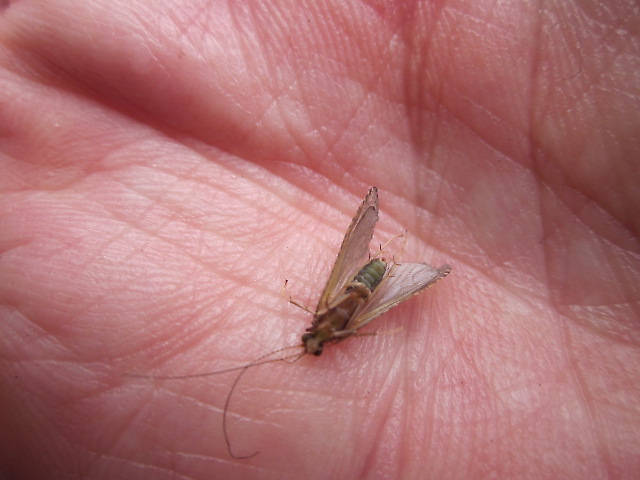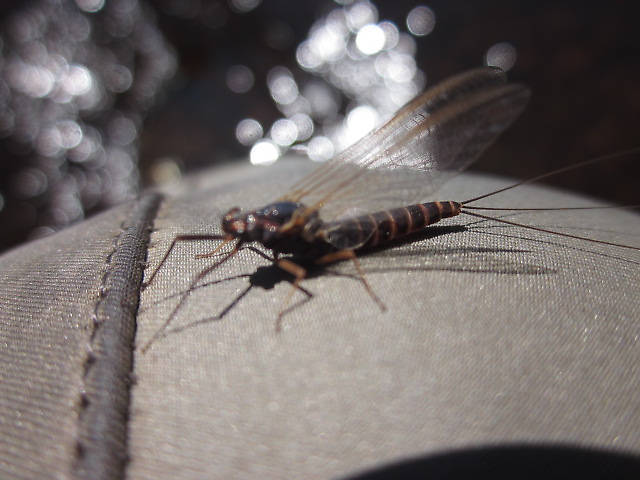Blog & Latest Updates
Fly Fishing Articles
Insects by Common Name


> > More Bugs!
Oldredbarn has attached these 5 pictures to aid in identification. The message is below.
| Oldredbarn | June 9th, 2011, 2:15 pm | |
| Novi, MI Posts: 2608 | Here are a few from the Au Sable between May 18th-29th... | |
| "Even when my best efforts fail it's a satisfying challenge, and that, after all, is the essence of fly fishing." -Chauncy Lively "Envy not the man who lives beside the river, but the man the river flows through." Joseph T Heywood | ||
| PaulRoberts | June 9th, 2011, 4:26 pm | |
| Colorado Posts: 1776 | Best guesses since I'm rusty on my Eastern bug now... E. invaria (with dusky wings). Or late subvaria? S. fuscum (or whatever they call it now -Macaffertia I think). Hyrdopsychae sp. (I never keyed them to species, but that looks just like the common rust-n-olive one that popped about now in central NY -starting when the flox began to flower). invaria imago? late subvaria? | |
| Entoman | June 9th, 2011, 7:43 pm | |
| Northern CA & ID Posts: 2604 | Hi Spence, Top two - Drunella cornuta female subimago (Blue Winged Olive) Third - Maccaffertium vicarium female subimago (Gray Fox) Fourth - Probably a Hydropsychid Fifth - Leptophlebia spc. female imago (Borcher Drake) Regards, Kurt | |
| "It's not that I find fishing so important, it's just that I find all other endeavors of Man equally unimportant... And not nearly as much fun!" Robert Traver, Anatomy of a Fisherman | ||
| Jmd123 | June 9th, 2011, 9:08 pm | |
| Oscoda, MI Posts: 2611 | Nice insect shots Spence! Good enough to tie imitations from... Jonathon | |
| No matter how big the one you just caught is, there's always a bigger one out there somewhere... | ||
| PaulRoberts | June 9th, 2011, 10:18 pm | |
| Colorado Posts: 1776 | Hi Spence, -Cornuta is much darker, and has wide fore-tarsae. -Vicarium is the March Brown (darker mottling). Fuscum is the paler "Gray Fox". -Definitely Hyropsychae. -Ah! Lepto. Yes. | |
| Oldredbarn | June 9th, 2011, 11:54 pm | |
| Novi, MI Posts: 2608 | Fuscum & vicarium are now listed as one under the Maccaffertium vicarium... What do we all think of Cheumatopsyche for the caddis as far as genus? Family Hydropsychidae as mentioned...As far as species I'd be in over my head...The "popcorn" label has been used, as far as I know, on at least two different caddis on the Au Sable, this one and a smaller light green/olive bodied grayer winged little one on the North Branch...When they are depositing their eggs they pop up and down on the water in a fairly violent manner trying to shake them eggs free...It's funny to watch. I think others may call it the Little Sister Sedge or Little Olive Sedge. I lean towards invaria for our gray winged sulpher, but if you look closely you will see that green/olive hue in the legs and thorax region I mentioned somewhere in another post some time back. In my experience the olive hue is more pronounced closer to emergence. The longer away from the water the more it seems to change. What ya think, folks? Someone kidnap the "Bug Boys"??? We haven't heard from our beloved triumverate (sp?) :) Gonzo, Taxon and Konchu? Spence | |
| "Even when my best efforts fail it's a satisfying challenge, and that, after all, is the essence of fly fishing." -Chauncy Lively "Envy not the man who lives beside the river, but the man the river flows through." Joseph T Heywood | ||
| Taxon | June 10th, 2011, 12:54 am | |
Site Editor Royse City, TXPosts: 1350 | Hi Spence- I would have to join the Leptophlebia bandwagon on number five, but would need better views to have opinions on the others. | |
| Best regards, Roger Rohrbeck www.FlyfishingEntomology.com | ||
| Oldredbarn | June 10th, 2011, 9:48 am | |
| Novi, MI Posts: 2608 | Roger, Yeah! Sorry about the photo quality...They were really after-thoughts...Fish rising on the one hand, stopping for photo shoot on the other...I blew out the really blurred ones. It's a drag when the automatic camera decides to give you a crystal clear, in-focus, shot of a seam in your waders and blurs the bug posing next to it... Spence | |
| "Even when my best efforts fail it's a satisfying challenge, and that, after all, is the essence of fly fishing." -Chauncy Lively "Envy not the man who lives beside the river, but the man the river flows through." Joseph T Heywood | ||
| Jmd123 | June 10th, 2011, 1:42 pm | |
| Oscoda, MI Posts: 2611 | Spence, same thing with me on wildflowers - nicely focused grass in the background, blurry blob of an orchid flower in the center... Jonathon | |
| No matter how big the one you just caught is, there's always a bigger one out there somewhere... | ||
| PaulRoberts | June 10th, 2011, 1:59 pm | |
| Colorado Posts: 1776 | I knew they'd changed the Stenonema's, but wasn't up on it. So vicarium and fuscum are color variations now. Same is true of subvaria (light and dark). The eastern Drunella's I'd seen and fished emerged a brighter olive qnd quickly darkened to a true olive. But...with possible color variations...mebbe so... Also, the Eastern Drunella's I fished were tighter early morning emergers, invaria coming mid-morning on. But...that's just what I saw of them. Here's link to a Drunella (cornutella) image showing the wide foretarsae. http://www.delawareriverguide.net/newnames/explain.html | |
| Entoman | June 10th, 2011, 2:09 pm | |
| Northern CA & ID Posts: 2604 | Paul --Cornuta is much darker, and has wide fore-tarsae. On my screen, the fly appears to have a dark blue gray wing and and a bright olive green body shading darker at the thorax. Can't make out enough in the photo to discuss femurs. Since nothing else can really be determined, I went on the basis of it's color alone which doesn't take into account variations possible within a species, let alone computer monitors (in other words, a guess). Having said that, the only common Eastern green Ephemerellid (there is a smaller one that hatches later) I'm aware of is cornuta (if what I'm seeing is accurate). Yeah, vicarium (March Brown) vs. fuscum (Grey Fox) caused me some confusion as well until Gonzo gave me the explanation. Spence is right that both are now the same species. The revision is not new as I had assumed, but is actually more than 30 years old. Since scientists have determined that both are actually substantial color variations of vicarium, it is still correct to call them either "Gray Foxes" or "March Browns", depending on which one shows up. Why some literature since this time perpetuates the confusion is proof that old habits die hard in our fraternity. Spence - In my experience the olive hue is more pronounced closer to emergence. The longer away from the water the more it seems to change. I've noticed the same thing at times with our Western sulfers, depending on species and watershed. Good thing to keep in mind when fish are working fresh duns. Regards, Kurt | |
| "It's not that I find fishing so important, it's just that I find all other endeavors of Man equally unimportant... And not nearly as much fun!" Robert Traver, Anatomy of a Fisherman | ||
| PaulRoberts | June 10th, 2011, 2:35 pm | |
| Colorado Posts: 1776 | I can see the foretarsa well enough in the first image -those legs are quite feeble. Another difference is the long abdomen and less robust thorax of invaria (and subvaria too) compared to the shorter abdomen and chunkier thorax of Drunella. These are gestalt perceptions, I haven't measured anything, so I could be mistaken. Trusting to my gestalt perceptions...that first bug is Ephemerella and it's too late and too yellow (on my screen) to be subvaria. invaria can have quite yellowish wings but some were light gray I remember noting. I actually wondered about how closely related subvaria and invaria might be --how recently they've (begun to) separated -the range of color and how close the earliest and latest of each appear. Or whether there was another species or subsp present -possibly Caucci's Ephemerella "X". I never followed up on that. Wonder if anyone has carefully made the collections then run the DNA on them? | |
| Entoman | June 10th, 2011, 2:58 pm | |
| Northern CA & ID Posts: 2604 | Wow, I need to look into my screen settings. Your guys description of yellowish or faint olive hues sure aren't what I'm seeing. Spence - does this fly turn to the basic tannish usually associated with subvaria/invaria or by darker did you mean more olive? | |
| "It's not that I find fishing so important, it's just that I find all other endeavors of Man equally unimportant... And not nearly as much fun!" Robert Traver, Anatomy of a Fisherman | ||
| Entoman | June 10th, 2011, 3:12 pm | |
| Northern CA & ID Posts: 2604 | Paul - BTW, could you expand a little on the differences in the legs? I'm not sure I'm following you. I know femurs are "big" in this family for determining nymphs and thought that was what you were referring to. What is it about a tarsus I should be looking at? | |
| "It's not that I find fishing so important, it's just that I find all other endeavors of Man equally unimportant... And not nearly as much fun!" Robert Traver, Anatomy of a Fisherman | ||
| Jmd123 | June 10th, 2011, 3:15 pm | |
| Oscoda, MI Posts: 2611 | Man, Spence, you sure set off the bugologists on this one! Jonathon | |
| No matter how big the one you just caught is, there's always a bigger one out there somewhere... | ||
| Oldredbarn | June 10th, 2011, 3:20 pm | |
| Novi, MI Posts: 2608 | -possibly Caucci's Ephemerella "X". Paul, I have wondered about this as well...I'm wondering if some of these "controversies" that have been discussed over time weren't maybe an angler vs entomologist view of the world thing. I mean we have all lived for years under the idea that fuscum and vicarium were two separate bugs...Different patterns etc... I think, bottom line, we are still a long way from getting it all straightened out between the two schools. Spence | |
| "Even when my best efforts fail it's a satisfying challenge, and that, after all, is the essence of fly fishing." -Chauncy Lively "Envy not the man who lives beside the river, but the man the river flows through." Joseph T Heywood | ||
| PaulRoberts | June 10th, 2011, 4:14 pm | |
| Colorado Posts: 1776 | Sorry Kurt, it's the femur I'm referring to. The Drunella nymphs have a very wide femur, and it shows up (although somewhat reduced) in the adults too. invaria stays yellow. Some have white eyes -what's that all about??? I have notes and images but really should be working (as in earning my living) here. Thus, you're getting the shadows of my past gestalt perceptions -guesses I think they could be called. lol As to "getting the bug guys going"... I guess I like them all: trout, bugs, birds, flowers, furry critters, mushrooms, ... -it's all cool stuff that can be interrelated in interesting ways. I like the story told by a Native American elder who said (paraphrased) that the trail of life is littered with little bits of paper, each with a message (and spread more or less randomly -mine). If you could pick up them all you'd understand "The "Great Mystery". "Guess I missed a few", he chuckled. | |
| Jmd123 | June 10th, 2011, 5:05 pm | |
| Oscoda, MI Posts: 2611 | Paul, I'm with you all the way on being fascinated by biodiversity, as you can probably gather from some of the photos I've posted on here. I'm a field biologist whether I'm getting paid for it (not often enough) or not (the rest of the time)... Jonathon | |
| No matter how big the one you just caught is, there's always a bigger one out there somewhere... | ||
| Entoman | June 10th, 2011, 6:24 pm | |
| Northern CA & ID Posts: 2604 | Paul -Sorry Kurt, it's the femur I'm referring to. The Drunella nymphs have a very wide femur, and it shows up (although somewhat reduced) in the adults too. Ah, thanks for clearing that up. Makes sense about the femurs being larger; I'll start looking at them more closely. | |
| "It's not that I find fishing so important, it's just that I find all other endeavors of Man equally unimportant... And not nearly as much fun!" Robert Traver, Anatomy of a Fisherman | ||
| Oldredbarn | June 12th, 2011, 1:00 pm | |
| Novi, MI Posts: 2608 | I know that relying on photographs can cause us problems when we are trying to determine the species of a mayfly, but...In 1995 on a trip to Montana I purchased the anniversary edition of "Hatches II" (Al Caucci & Bob Nastasi) at Blue Ribbon Flies in West Yellowstone. There are some wonderful color photo plates in there and the pictures of invaria are very, very close to my little yellow bug...cornuta is there as well and appears to be a much darker olive bug. Paul's mention of Ephemerella x drove me to pull the book off my shelf in the fly tying room. Still no taker's though on my little green bodied caddis? :) Spence | |
| "Even when my best efforts fail it's a satisfying challenge, and that, after all, is the essence of fly fishing." -Chauncy Lively "Envy not the man who lives beside the river, but the man the river flows through." Joseph T Heywood | ||
Quick Reply
You have to be logged in to post on the forum. It's this easy:
Related Discussions
| Title | Replies | Last Reply |
| Re: egg sack color In the Mayfly Family Heptageniidae by LittleJ | 3 | May 20, 2007 by LittleJ |
| Re: Hydropsyche In Neophylax Caddisfly Adult by Taxon | 1 | Oct 5, 2006 by GONZO |
| Re: fly names In General Discussion by Konchu | 2 | May 28, 2009 by GONZO |
| Re: CDC Dry Fly Midge - size 26 hook! In Fly Tying by Mcflyangler | 4 | Feb 12, 2019 by Jawyellowba |
| Re: Family ID for this one? In Isoperla Stonefly Adult by Troutnut | 2 | Jul 30, 2006 by Troutnut |
| Re: Serratella In the Mayfly Genus Serratella by Goose | 1 | Oct 4, 2006 by Troutnut |
| Re: Grannoms In Brachycentrus Caddisfly Pupa by Martinlf | 7 | Jan 8, 2013 by Martinlf |
| Re: Ribbing/Suggestions In Fly Tying by Lastchance | 10 | Apr 2, 2013 by Feathers5 |
| Re: LAKE KHOBI (GEORGIA) In General Discussion by Kinalia | 4 | Jan 7, 2013 by Mcjames |
| Re: Maccaffertium spinner, maybe?? In the Identify This! Board by Wiflyfisher | 9 | Jun 13, 2008 by Wiflyfisher |
Troutnut.com is copyright © 2004-2024 Jason
Neuswanger (email Jason). See my FAQ for information about use of my images.
 privacy policy
privacy policy

